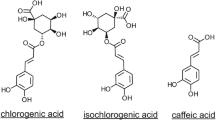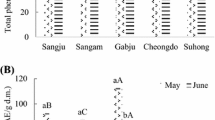Abstract
This study was conducted to compare antioxidant contents and antioxidative activities in the leaves and petioles of six sweet potato varieties, namely Danjami, Hayanmi, Hogammi, Jinyulmi, Poongwonmi, and Yeonjami. Total amount of phenolic acids was highest in Poongwonmi and lowest in Hogammi, while vitamin C level was highest in Danjami. Of four phenolic acids quantified, 3,5-dicaffeoylquinic acid was the most abundant in all varieties. The contents of phenolic acids and vitamin C were more than ten-fold higher in the leaves compared with the petioles. In addition, the leaves had much lower EC50 values for DPPH scavenging activities and reducing power than the petioles, indicating that sweet potato leaves have a higher antioxidant capacity than the petioles. Blanching, including conventional and microwave, resulted in a considerable decrease of antioxidant content and activity in the leaves due to thermal degradation and leaching.


Similar content being viewed by others
References
Chu, Y.H., Chang, C.L. and Hsu, H.F. 2000. Flavonoid content of several vegetables and their antioxidant activity. J. Sci. Food Agric. 80: 561–566.
Food and Agriculture Organization of the United Nations (FAOSTAT). 2017. Sweet potato world production. Available from: http://www.fao.org/faostat/en/#data/QC. Accessed Sep. 20, 2017.
Gupta, S., Lakshmi, A.J. and Prakash, J. 2008. Effect of different blanching treatments on ascorbic acid retention in green leafy vegetables. Nat. Prod. Rad. 7(2): 111–116.
Hue, S.M., Boyce, A.N. and Somasundram, C. 2012. Antioxidant activity, phenolic, and flavonoid contents in the leaves of different varieties of sweet potato (Ipomoea batatas). Aust. J. Crop Sci. 6: 375–380.
Irondi, E.A., Akintunde, J.K., Agboola, S.O., Boligon, A.A. and Athayde, M.L. 2017. Blanching influences the phenolics composition, antioxidant activity, and inhibitory effect of Adansonia digitata leaves extract on α‐amylase, α‐glucosidase, and aldose reductase. Food Sci. Nutr. 5(2): 233–242.
Ishida, H., Suzuno, H., Sugiyama, N., Innami, S., Tadokoro, T. and Maekawa, A. 2000. Nutritive evaluation on chemical components of leaves, stalks, and stems of sweet potatoes (Ipomoea batatas poir). Food Chem. 68: 359–367.
Islam, M.S., Yoshimoto, M. and Yamakawa O. 2003. Distribution and physiological functions of caffeoylquinic acid derivatives in leaves of sweet potato genotypes. J. Food Sci. 68(1): 111–116.
Jung, J.K. and Im, H.W. 2012. The total phenolic contents of Korean sweet potato according to physical characteristics and cooking methods. Foodserv. Ind. J. 8(1): 53–74.
Jung, J.K., Leem S.U., Kozukue, N., Levin, C.E. and Friedman, M. 2011. Distribution of phenolic compounds and antioxidative activities in parts of sweet potato (Ipomea batatas L.) plants and in home processed roots. J. Food Comp. Anal. 24: 29–37.
Koh, E., Charoenprasert, S., Mitchell, A.E. 2012. Effect of organic and conventional cropping systems on ascorbic acid, vitamin C, flavonoids, nitrate, and oxalate in 27 varieties of spinach (Spinacia oleracea L.). J. Agri. Food Chem. 60: 3144 − 3150.
Korea Health Industry Development Institute (KHIDI). 2016. National Food & Nutrition Statistics 2014: based on 2014 Korea National and Nutrition Examination Survey. Korea Health Industry Development Institute, Osong, Korea, p.30.
Li, M., Jang, G.Y., Lee, S.H., Woo, K.S., Sin, H.M., Kim, H.S., Lee, J. and Jeong, H.S. 2012. Chemical compositions and antioxidant activities of leaves and stalks from different sweet potato cultivars. J. Korean Soc. Food Sci. Nutr. 41(12): 1656–1662.
Liao, W.C., Lai, Y.C., Yan, M.C., Hsu, Y.L. and Chan, C.F. 2011. Antioxidant activity of water extract of sweet potato leaves in Taiwan. Food Chem. 127: 1224–1228.
Nur Alam, Md., Jahan Bristi, N. and Rafiquzzaman, Md. 2013. Review on in vivo and in vitro methods evaluation of antioxidant activity. Saudi Pharm. J. 21(2): 143–152.
Oyaizu, M. 1986. Studies on products of browning reactions: antioxidative activities of products of browning reaction prepared from glucosamine. Jpn. J. Nutr. Diet 44: 307–315.
Ruiz-Ojeda, L.M., Peñasm F.J. 2013. Comparison study of conventional hot-water and microwave blanching on quality of green beans. Innov. Food Sci. Emerg. Technol. 20: 191–197.
Rural Development Administration (RDA). 2011. Rural Development Administration Food Composition Table 8th ed. Gyomoon Press, Paju, Korea, pp.118–119.
Singleton, V.L., Orthofer, R. and Lamuela-Raventos, R.M. Analysis of total phenols and other oxidation substrates and antioxidants by means of Folin-Ciocalteau reagent. Method Enzymol. 299: 152–178.
Sun, H., Mu, T., Xi, L. and Song, Z. 2014. Effects on domestic cooking methods on polyphenols and antioxidant activity of sweet potato leaves. J. Agric. Food Chem. 62(36): 8982–8989.
Truong, V.D., McFeeters, R.F., Thompson, R.T., Dean, L.L. and Shofran, B. 2007. Phenolic acid content and composition in leaves and roots of common commercial sweet potato (Ipomea batatas L.) varieties in the United States. J. Food Sci. 72: C343–C349.
Turkmen, N., Sari, F. and Velioglu, S. 2005. The effect of cooking methods on total phenolics and antioxidant activity of selected green vegetables. Food Chem. 93(4): 713–718.
Wu, X., Sun, C., Yang, C., Zeng, G., Liu, Z. and Li, Y. 2008. β-carotene content in sweet potato varieties from China and the effect of preparation on β-carotene retention in the Yanshu No. 5. Innov. Food Sci. Emerg. Technol. 9: 581–586.
Yoshinaga, M., Yamakawa, O. and Nakatani, M. 1999. Genotypic diversity of anthocyanin content and composition in purple-fleshed sweet potato (Ipomoea batatas (L.) Lam). Breed Sci. 49: 43–47.
Zhang, D. and Hamauzu, Y. 2004. Phenolics, ascorbic acid, carotenoids and antioxidant activity of broccoli and their changes during conventional and microwave cooking. Food Chem. 88: 503–509.
Acknowledgements
The authors are grateful to the Bioenergy Crop Research Center, which provided the petioles and leaves of six sweet potato varieties. This work was supported by a research grant from Seoul Women’s University (2018).
Author information
Authors and Affiliations
Corresponding author
Rights and permissions
About this article
Cite this article
Jang, Y., Koh, E. Antioxidant content and activity in leaves and petioles of six sweet potato (Ipomoea batatas L.) and antioxidant properties of blanched leaves. Food Sci Biotechnol 28, 337–345 (2019). https://doi.org/10.1007/s10068-018-0481-3
Received:
Revised:
Accepted:
Published:
Issue Date:
DOI: https://doi.org/10.1007/s10068-018-0481-3




